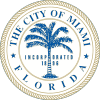Miami accent
The Miami accent is an evolving American English regional accent, or sociolect-in-formation, spoken in South Florida, particularly in Dade, originating from central Miami. The Miami accent is most prevalent in younger, Hispanic, locally-born South Floridians who live in greater Miami and Miami Beach .[1] This ethnolect is a native variety of English.
Origin
The Miami accent developed amongst second- or third-generation Miamians, particularly young adults whose first language was English, but were bilingual. Since World War II, Miami's population has grown rapidly every decade, due in part to the post-war baby boom. In 1950, the US Census stated that Dade County's population was 495,084. Beginning with rapid international immigration and the Cuban exodus of the late 1950s, Miami's population has drastically grown every decade since then. Many of these immigrants began to inhabit the urban industrial area around Downtown Miami. By 1970, the US Census stated that Dade County's population was 1,267,792. By 2000, the population reached 2,253,362.[2] Growing up in Miami's urban center, second-, third-, and fourth-generation Miamians of the immigration wave of the 1960s and 1970s, developed the Miami accent.[1][3] It is now the customary dialect of many citizens in the Miami metropolitan area.
Phonological characteristics
The following are typical phonological (pronunciation) characteristics of the Miami accent:
- Rhoticity (i.e. the pronunciation of the postalveolar "R" sound in all environments), like with most American English; also, though rarely, a "rolled R" may be heard after a consonant.[4]
- Pronunciation of (the "short a" as in the words class, rap, hand, etc.) with the jaw and/or tongue more lowered than in a General American accent, thus approaching .[1]
- Clear alveolar "L" () only, unlike the relatively dark velar "L" () of General American.[5]
- High rising terminal (also known as "upspeak"): a rising intonation may be heard at the ends of declarative statements (making them sound like questions), similar to the stereotype of "Valley Girl speech."[5]
- Cot–caught merger in transition: the vowel sounds in words like cot versus caught, clod versus clawed, pond versus pawned, etc. are beginning to merge into a single sound.[6]
It is possible to differentiate this variety from an interlanguage spoken by second language speakers in that this ethnolect does not generally display the following features:
- There are no confusions of tense and lax vowels, outside contexts where other native speakers often vary usage.
- There is no addition of /ɛ/ before initial consonant clusters with /s/.
- Speakers do not confuse of /dʒ/ with /j/, (e.g., Yale with jail).
- Speakers do not use the alveolar tap [ɾ] or alveolar trill [r] of Spanish.
Lexical characteristics
Speakers of the Miami accent may be heard to use "calques": idioms (that would sound awkward or unusual to other native English speakers). For example, instead of saying, "lets get out of the car," someone from Miami might say, "let's get down from the car". Other Miami terms especially common among Miami youth, often called "slang," include:[7]
- Chonga: a particular South Florida Hispanic female fashion and associated youth subculture
- Irregardless: regardless
- Mission: anything that takes a long time (as in "What a mission!" or something being "Such a mission"); similar to the use of "a chore" in the same context
- Supposably: supposedly
- "Took the light": Running a yellow light in traffic
- "Eating shit": Hanging out, or teasing someone
Notable lifelong native speakers
- Gloria Estefan — "There are certainly successful people with the Miami accent, among them singer Gloria Estefan"[4]
- Danell Leyva
- Pitbull
- Andy Garcia
See also
External links
- Origins of the Miami accent (WLRN)
- Birth of the Miami accent
- Comedic representation of Miamians with the Miami accent
- ¿Qué Pasa, USA? - Episode One
References
- ^ a b c Watts, Gabriella. "Miami Accents: How 'Miamah' Turned Into A Different Sort Of Twang". wlrn.org.
- ^ "Miami's Spanish-Speaking Population Outnumber English Speakers". Huffington Post. 2008-05-29.
- ^ http://www.businessinsider.com/miami-has-a-unique-english-dialect-2013-9
- ^ a b "'Miami Accent' Takes Speakers By Surprise". Articles – Sun-Sentinel.com. June 13, 2004. Retrieved 2012-10-08.
- ^ a b Patience Haggin. "Miami Accents: Why Locals Embrace That Heavy "L" Or Not". wlrn.org.
- ^ Labov, William; Ash, Sharon; Boberg, Charles (2006). The Atlas of North American English. Berlin: Mouton-de Gruyter. p. 61. ISBN 3-11-016746-8.
- ^ Kyle Munzenrieder. "Miami Slang Glossary: Pero Like, It's Super-Definitive, Bro". Miami New Times.

